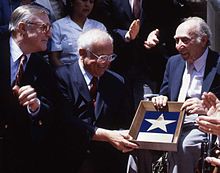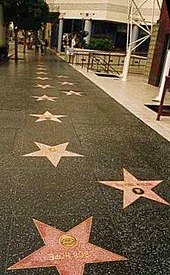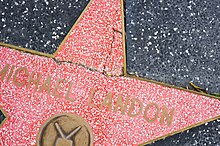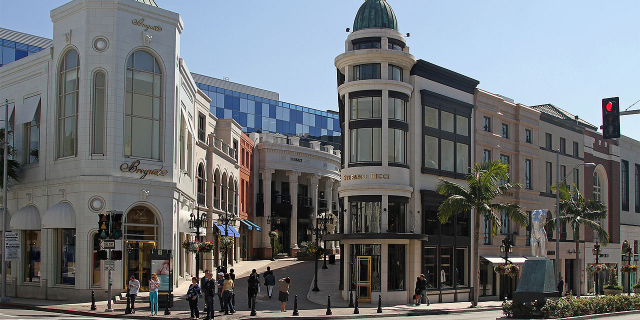Hollywood Walk of Fame
The Hollywood Walk of Fame is a historic landmark which consists of more than 2,765 five-pointed terrazzo-and-brass stars embedded in the sidewalks along 15 blocks of Hollywood Boulevard and three blocks of Vine Street in Hollywood, California. The stars are monuments to achievement in the entertainment industry, bearing the names of a mix of actors, directors, producers, musicians, theatrical/musical groups, fictional characters, and others.
The Walk of Fame is administered by the Hollywood Chamber of Commerce, who hold the trademark rights, and maintained by the self-financing Hollywood Historic Trust. It is a popular tourist attraction, receiving an estimated 10 million annual visitors in 2010.
 The Walk of Fame at the 6800 block of Hollywood Boulevard with the Dolby Theatre in the foreground and the intersection of Hollywood Boulevard and Highland Avenue
The Walk of Fame at the 6800 block of Hollywood Boulevard with the Dolby Theatre in the foreground and the intersection of Hollywood Boulevard and Highland AvenueThe Hollywood Chamber of Commerce credits E.M. Stuart, its volunteer president in 1953, with the original idea for creating a Walk of Fame. Stuart reportedly proposed the Walk as a means to "maintain the glory of a community whose name means glamour and excitement in the four corners of the world".[1] Harry Sugarman, another Chamber member and president of the Hollywood Improvement Association, received credit in an independent account.[2] A committee was formed to flesh out the idea, and an architectural firm was retained to develop specific proposals. By 1955, the basic concept and general design had been agreed upon, and plans were submitted to the Los Angeles City Council.[3][4][5]
Multiple accounts exist for the origin of the star concept. According to one, the historic Hollywood Hotel, which stood for more than 50 years on Hollywood Boulevard at the site now occupied by the Ovation Hollywood complex and the Dolby (formerly Kodak) Theatre[6]—displayed stars on its dining room ceiling above the tables favored by its most famous celebrity patrons, and that may have served as an early inspiration.[3] By another account, the stars were "inspired ... by Sugarman's Tropics Restaurant drinks menu, which featured celebrity photos framed in gold stars".[2][7]
In February 1956, a prototype was unveiled featuring a caricature of an example honoree (John Wayne, by some accounts[8]) inside a blue star on a brown background.[1] However, caricatures proved too expensive and difficult to execute in brass with the technology available at the time; and the brown and blue motif was vetoed by Charles E. Toberman, the legendary real estate developer known as "Mr. Hollywood", because the colors clashed with a new building he was erecting on Hollywood Boulevard.[1][9]
Selection and constructionBy March 1956, the final design and coral-and-charcoal color scheme had been approved. Between the spring of 1956 and the fall of 1957, 1,558 honorees were selected by committees representing the four major branches of the entertainment industry at that time: motion pictures, television, audio recording, and radio. The committees met at the Brown Derby restaurant,[10] and they included such prominent names as Cecil B. DeMille, Samuel Goldwyn, Jesse L. Lasky, Walt Disney, Hal Roach, Mack Sennett, and Walter Lantz.[1]
 Joanne Woodward's star, contrary to popular belief, was not the first.
Joanne Woodward's star, contrary to popular belief, was not the first.A requirement stipulated by the original audio recording committee (and later rescinded) specified minimum sales of one million records or 250,000 albums for all music category nominees. The committee soon realized that many important recording artists would be excluded from the Walk by that requirement. As a result, the National Academy of Recording Arts and Sciences was formed to create a separate award for the music industry, leading to the first Grammy Awards in 1959.[11]
Construction of the Walk began in 1958, but two lawsuits delayed completion. The first lawsuit was filed by local property owners challenging the legality of the $1.25 million tax assessment (equivalent to $13 million in 2022) levied upon them to pay for the Walk, along with new street lighting and trees. In October 1959, the assessment was ruled legal.[1] The second lawsuit, filed by Charles Chaplin Jr., sought damages for the exclusion of his father, whose nomination had been withdrawn due to pressure from multiple quarters (see Controversial additions). Chaplin's suit was dismissed in 1960, paving the way for completion of the project.[1][12][13]
While Joanne Woodward is often singled out as the first person to receive a star on the Walk of Fame—possibly because she was the first to be photographed with it[14]—the original stars were installed as a continuous project, with no individual ceremonies. Woodward's name was one of eight drawn at random from the original 1,558 and inscribed on eight prototype stars that were built while litigation was holding up permanent construction.[15][16][17] The eight prototypes were installed temporarily on the northwest corner of Hollywood Boulevard and Highland Avenue in August 1958 to generate publicity and to demonstrate how the Walk would eventually look.[1] The other seven names were Olive Borden, Ronald Colman, Louise Fazenda, Preston Foster, Burt Lancaster, Edward Sedgwick, and Ernest Torrence.[1][18] Official groundbreaking took place on February 8, 1960.[3] On March 28, 1960, the first permanent star, director Stanley Kramer's, was completed on the easternmost end of the new Walk near the intersection of Hollywood and Gower.[1][19]
Stagnation and revitalizationAlthough the Walk was originally conceived in part to encourage redevelopment of Hollywood Boulevard, the 1960s and 1970s were periods of protracted urban decay in the Hollywood area as residents moved to nearby suburbs.[20][21] After the initial installation of approximately 1,500 stars in 1960 and 1961, eight years passed without the addition of a new star. In 1962, the Los Angeles City Council passed an ordinance naming the Hollywood Chamber of Commerce "the agent to advise the City" about adding names to the Walk, and the Chamber, over the following six years, devised rules, procedures, and financing methods to do so.[1] In December 1968, Richard D. Zanuck was awarded the first star in eight years in a presentation ceremony hosted by Danny Thomas.[1][10][22] In July 1978, the city of Los Angeles designated the Hollywood Walk of Fame a Los Angeles Historic-Cultural Monument.[23]
 Johnny Grant, center, at the July 29, 1991 presentation ceremony for producer Joe Pasternak, on the right. At left is Gene Kelly.
Johnny Grant, center, at the July 29, 1991 presentation ceremony for producer Joe Pasternak, on the right. At left is Gene Kelly.Radio personality, television producer, and Chamber member Johnny Grant is generally credited with implementing the changes that resuscitated the Walk and established it as a significant tourist attraction.[10][24] Beginning in 1968, Grant stimulated publicity and encouraged international press coverage by requiring that each recipient personally attend his or her star's unveiling ceremony.[10] Grant later recalled that "it was tough to get people to come accept a star" until the neighborhood finally began its recovery in the 1980s.[21]
In 1980, Grant instituted a fee of $2,500 (equivalent to $8,879 in 2022), payable by the person or entity nominating the recipient, to fund the Walk of Fame's upkeep and minimize further taxpayer burden.[10] The fee has increased incrementally over time. By 2002, it had reached $15,000 (equivalent to $24,405 in 2022),[25] and stood at $30,000 in 2012 (equivalent to $38,240 in 2022).[26] As of 2023[update], the fee was $75,000, about nine times the original amount adjusted for inflation.[27]
Grant was himself awarded a star in 1980 for his television work.[1] In 2002, he received a second star in the "special" category to acknowledge his pivotal role in improving and popularizing the Walk.[28] He was also named chairman of the Selection Committee and Honorary Mayor of Hollywood (a ceremonial position previously held by Art Linkletter and Monty Hall,[29][30] among others).[1][28] He remained in both offices from 1980 until his death in 2008 and hosted the great majority of unveiling ceremonies during that period. His unique special-category star, with its emblem depicting a stylized "Great Seal of the City of Hollywood",[31] is located at the entrance to the Dolby Theatre adjacent to Johnny Grant Way.[32][33]
ExpansionIn 1984, a fifth category, Live Theatre, was added to acknowledge contributions from the live performance branch of the entertainment industry, and a second row of stars was created on each sidewalk to alternate with the existing stars.[1]
 Hollywood Boulevard, 7000 block, north side, looking westward
Hollywood Boulevard, 7000 block, north side, looking westwardIn 1994, the Walk of Fame was extended one block to the west on Hollywood Boulevard, from Sycamore Avenue to North LaBrea Avenue (plus the short segment of Marshfield Way that connects Hollywood and La Brea), where it now ends at the silver "Four Ladies of Hollywood" gazebo and the special "Walk of Fame" star.[34] At the same time, Sophia Loren was honored with the 2,000th star on the Walk.[1]
During construction of tunnels for the Los Angeles subway system in 1996, the Metropolitan Transportation Authority (MTA) removed and stored more than 300 stars.[35] Controversy arose when the MTA proposed a money-saving measure of jackhammering the 3-by-3-foot terrazzo pads, preserving only the brass lettering, surrounds, and medallions, then pouring new terrazzo after the tunnels were completed;[36] but the Cultural Heritage Commission ruled that the star pads were to be removed intact.[37]
In 2023, a sixth category, Sports Entertainment, was added to acknowledge contributions of athletes to the entertainment industry.[38]
Restoration Michael Landon's slightly cracked star
Michael Landon's slightly cracked starIn 2008, a long-term restoration project began with an evaluation of all 2,365 stars on the Walk at the time, each receiving a letter grade of A, B, C, D, or F. Honorees whose stars received F grades, indicating the most severe damage, were Joan Collins, Peter Frampton, Dick Van Patten, Paul Douglas, Andrew L. Stone, Willard Waterman, Richard Boleslavsky, Ellen Drew, Frank Crumit, and Bobby Sherwood. Fifty celebrities' stars received "D" grades. The damage ranged from minor cosmetic flaws caused by normal weathering to holes and fissures severe enough to constitute a walking hazard. Plans were made to repair or replace at least 778 stars at an estimated cost of over $4 million.[39]
The restoration is a collaboration among the Hollywood Chamber of Commerce and various Los Angeles city and county governmental offices, along with the MTA, which operates the Metro B Line that runs beneath the Walk, since earth movement due to the presence of the subway line is thought to be partly responsible for the damage.[40]
To encourage supplemental funding for the project by corporate sponsors, the "Friends of Walk of Fame" program was inaugurated,[39] with donors recognized through honorary plaques adjacent to the Walk of Fame in front of the Dolby Theatre.[41] The program has received some criticism; Alana Semuels of the Los Angeles Times described it as "just the latest corporate attempt to buy some good buzz", and quoted a brand strategist who said, "I think Johnny Grant would roll over in his grave".[41]
Los Angeles introduced the "Heart of Hollywood Master Plan", which promotes the idea of closing Hollywood Boulevard to traffic and creating a pedestrian zone from La Brea Avenue to Highland Avenue, citing an increase in pedestrian traffic including tourism, weekly movie premieres[42] and award shows closures, including ten days for the Academy Award ceremony at the Dolby Theatre.[43][44] In June 2019, the city of Los Angeles commissioned Gensler Architects to provide a master plan for a $4 million renovation to improve and "update the streetscape concept" for the Walk of Fame.[45][46][47] Los Angeles city councilmember Mitch O'Farrell released the draft master plan designed by Gensler and Studio-MLA in January 2020. It proposed widening the sidewalks, adding bike lanes, new landscaping, sidewalk dining, removing lanes of car traffic and street parking between the Pantages Theater (Gower Street) at the east and The Emerson Theatre (La Brea Avenue) at the west end of the boulevard.[48] The approved phase one includes removing the parking lanes between Orange Drive and Gower Street, adding street furnishings with benches, tables and chairs with sidewalk widening. Phase two is in the schematic stage. Phase two is planned for 2024 and will include closing down the boulevard to two lanes, adding landscaping with shade trees and five public plazas made up of art deco designed street pavers and kiosks.[49][50] Planned to be completed by 2026, funding is being raised for the $50 million project.[51][52]




































Add new comment